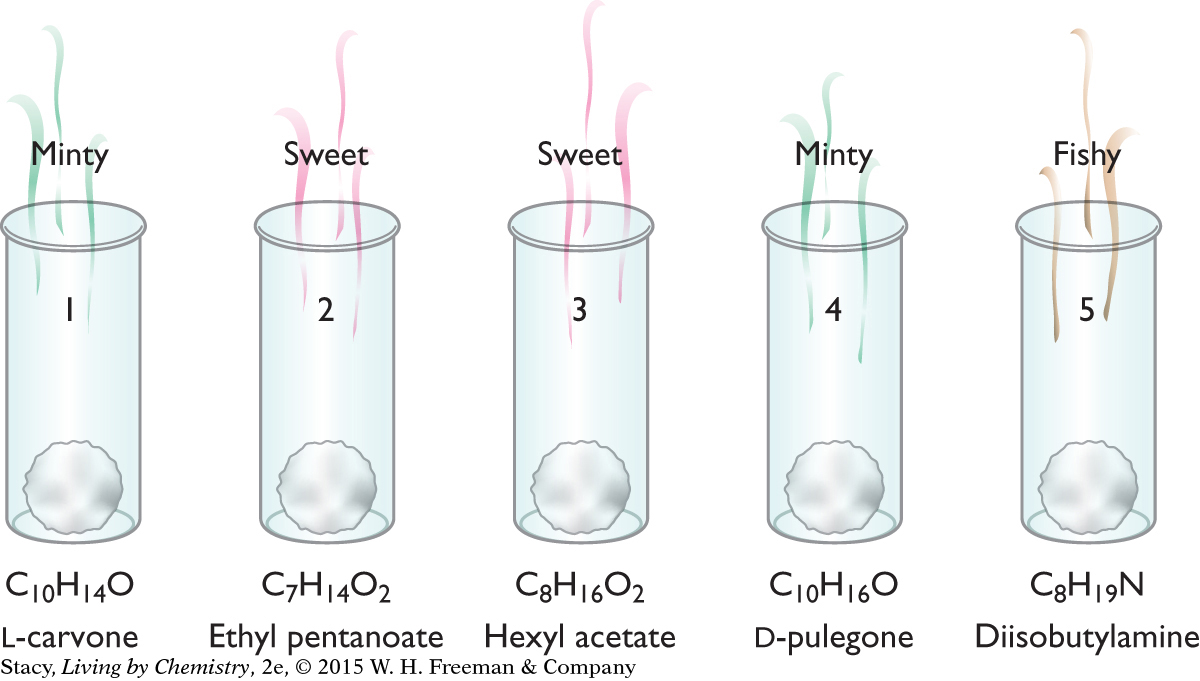LESSON 28: Sniffing Around: Molecular Formulas
147
THINK ABOUT IT
The topic of smell is both friendly and familiar. Most of us have had many experiences with smells: smells that attract, smells that disgust, and smells that evoke strong memories of vacations, holidays, or other experiences. It turns out that our noses are fantastic chemical detectors. Learning more about your nose and how it works will help you learn more about chemistry.
What does chemistry have to do with smell?
To answer this question, you will explore
The Sense of Smell
Classifying Smells
Molecular Formula, Name, and Smell
The Sense of Smell
EXPLORING THE TOPIC
The Sense of Smell
BIOLOGY CONNECTION
BIOLOGY
CONNECTION
Not every human being experiences smell in exactly the same way. Some people may smell one odor completely differently from other people or may not smell that one odor at all. These exceptions are of particular interest to smell researchers, who use this information to figure out how many distinct smells the nose can detect.

Someone opens a perfume bottle across the room. After a few seconds, you notice the sweet smell of the perfume. How did the smell get to your nose and how did your nose detect it?
The smells that come from a vial of perfume and end up in your nose are made of molecules. Molecules are groups of nonmetal atoms that are covalently bonded together. In this unit, you will examine mechanisms that your nose uses to detect and distinguish various smells.
To be consistent, you will always work with the consensus smell. In other words, you will work with the smell reported by the majority of your classmates.
Classifying Smells
Classifying Smells
To compare smells, we need a common language for describing them. How would you describe the smells of the items in these pictures?

© Elenhil/iStockphoto
|

© J.Garcia/photocuisine/Corbis
|

Don Farrall/Getty Images
|
148
BIOLOGY CONNECTION
BIOLOGY
CONNECTION
A moth uses its antennae to detect smells, while a snake uses its tongue.

Scientists classify smells by placing similar-smelling substances in the same category. For example, apples, bananas, strawberries, and pineapples might all fit into a category called “fruity” smelling. Roses, geraniums, and lilies might all fit into a category called “floral” smelling. Further, fruity- and floral-smelling substances might be grouped together in a larger category called “sweet” smelling.
Not all scientists agree on the specific names for smell categories or on the number of different categories that should exist. As you begin studying smells, you will start with three categories: sweet, minty, and fishy.
Molecular Formula, Name, and Smell
Molecular Formula, Name, and Smell
Important to Know
A molecular formula is a chemical formula for a molecular covalent compound. Recall that chemical formulas can describe other compounds that are not molecules.
A closer investigation reveals connections among a substance’s chemical name, its chemical formula, and its smell. For a molecular covalent compound, the chemical formula is also called the molecular formula, because it describes the makeup of each molecule.
Examine the drawings of the five vials. Each vial contains a cotton ball soaked in a different molecular compound. See if you can find any connections between the smells and their chemical names and molecular formulas.

HEALTH CONNECTION
HEALTH
CONNECTION
Dogs are trained to sniff out everything from termites and drugs to bombs and natural gas leaks. There is evidence that some dogs may even be able to detect when a person has developed certain cancers.

Here are some patterns that you might notice.
ALL THE MOLECULES
contain carbon and hydrogen atoms
have more hydrogen atoms than carbon atoms
are composed of three different types of atoms
SWEET-SMELLING MOLECULES
contain two oxygen atoms
have twice as many hydrogen atoms as they do carbon atoms
have two-word names ending in “-ate”
MINTY-SMELLING MOLECULES
contain one oxygen atom
contain ten carbon atoms
have even numbers of carbon and hydrogen atoms
have names ending in “-one”
149
FISHY-SMELLING MOLECULES
contain a nitrogen atom
do not contain oxygen atoms
Perhaps every molecule with two oxygen atoms smells sweet. Perhaps every molecule that smells fishy contains a nitrogen atom. These are reasonable hypotheses based on very little data. You can test these hypotheses by gathering more data.
Example
Predicting Smell
How would you expect a molecule with the molecular formula C9H18O2 to smell? Explain.
Solution
The molecule has two oxygen atoms. Based on data given so far, this suggests that the molecule smells sweet. It would be useful to know the name to confirm this. So far, we have seen that the names of sweet-smelling molecules end in “-ate.”
LESSON SUMMARY
LESSON SUMMARY
What does chemistry have to do with smell?
KEY TERMS
molecular formula
The smells that your nose detects are made of molecules. The molecular formulas and chemical names of molecular substances are directly related to the way these substances smell. You may be able to predict the smell of a substance by examining its chemical formula, its chemical name, or both.
Exercises
Reading Questions
How do scientists classify smells? What purpose might this serve?
From the evidence so far, how are molecular formulas related to smell? How are chemical names related to smell?
Reason and Apply
Name five substances from home that do not fit into the smell categories of sweet, minty, or fishy. What new categories would you put them in?
Make a list of five things from home that have no smell.
In a paragraph or two, write about one of the following. You may use a cartoon format instead, if you wish.
Describe a memory that you have that relates to smell. Describe the smell itself and what it reminds you of. (Avoid using adjectives that are not informative, such as “weird.”)
If you were a smell superhero, how would you use your smell superpowers or your enhanced sense of smell to assist the world?
150
What would your life be like if you couldn’t smell?
Try tasting something while having your nose plugged and your eyes closed. You may wish to work with a partner who can provide you with a variety of different-flavored jelly beans or other food items to sample.
Describe your experience. How difficult is it to taste something when you can’t smell it and you don’t know what it is?
How do you think taste is related to smell?
Predict the smells of these molecules. Explain your reasoning.
methyl octenoate, C9H18O2
monoethylamine, C2H7N
ethyl acetate, C4H8O2
What do you think 1,5-pentanedithiol (C5H12S2) would smell like? How confident of your answer are you? Explain why.
What makes something smell the way it does? Discuss your own hypothesis about why different things smell different. Include questions you still have.